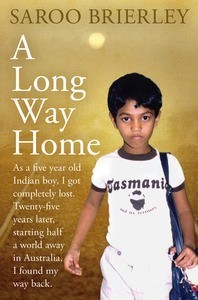
A Long Way Home
by Saroo Brierley
Viking (Australia), 2013
Reviewed by Barbara Free
I first bought the book to compare it to the film, to see if the film was true to the real story, and to learn more details. I was not disappointed. The book is every bit as powerful as the film. I could not put it down and read it in 24 hours.
The author is a fine writer and an amazing young man. The book contains much more about his childhood, his incredible journey as a lost five-year-old from the Bengal region to the streets of Calcutta (now called Kolkata), to adoption by an Australian couple who lived in Tasmania. It details his life on the streets, his rescue by someone who got him into a safe children’s home, where a very kind woman taught him and other children proper manners and helped them find homes. Although he faced many dangers along the way, somehow he managed to survive and found people who helped him. It is incredible to most of us that a five-year-old could survive even one day by himself, let alone months in the streets of Calcutta, living on garbage, with no one to turn to, and nothing familiar, not even the language.
When one reads the book, it becomes obvious that even before Saroo got lost on the train, he was pretty self-sufficient. He had left with his brother, Guddu, who was not much older, to find work. He was already responsible for his younger siblings while their mother was working long hours literally breaking rocks. He knew how to forage for food, or steal some, or trade tasks for food. Compared to American five-year-olds of today, he was already taking on adult responsibilities. Still, his survival and subsequent life seems amazing. His long years of searching for his hometown and his eventual reunion with his birth family are equally incredible. Google Earth should use his story as publicity for what is possible!
Saroo’s adoptive family seems amazing, too. His adoptive brother was not as disturbed as was depicted in the film, and both of them work in their father’s business. Both adoptive parents supported his search, although he did not realize that part of the time, and thought he should shield them, particularly his mother, from knowing. The truth is, had all these events not happened to him, including getting lost and eventually adopted, he could not have had a successful life. In fact, had he and his older brother, who was killed the night Saroo got lost, remained at home, their mother could never have been able to send any of her five children to school. She was able to afford school fees for the younger ones only because Guddu and Saroo were no longer there. That is a very sad reason for his siblings to have been able to become educated and have successful lives. Toward the end of the book, he says, “I began to realize that just as my search for my mother had in some ways shaped my life, her faith that I was alive had shaped hers. She couldn’t search, but she did the next best thing: she stayed still.” She remained in the same town, even though she might have been better off somewhere else, because she wanted to remain where she was in case Saroo returned. Many birth mothers who relinquished their children have done the same, hoping those children would eventually search for them.
Even if one has seen the film, the book is well worth finding and reading. It is inspirational in the most profound way. It is available through Amazon.
Excerpted from the October 2017 edition of the Operation Identity Newsletter
© 2017 Operation Identity